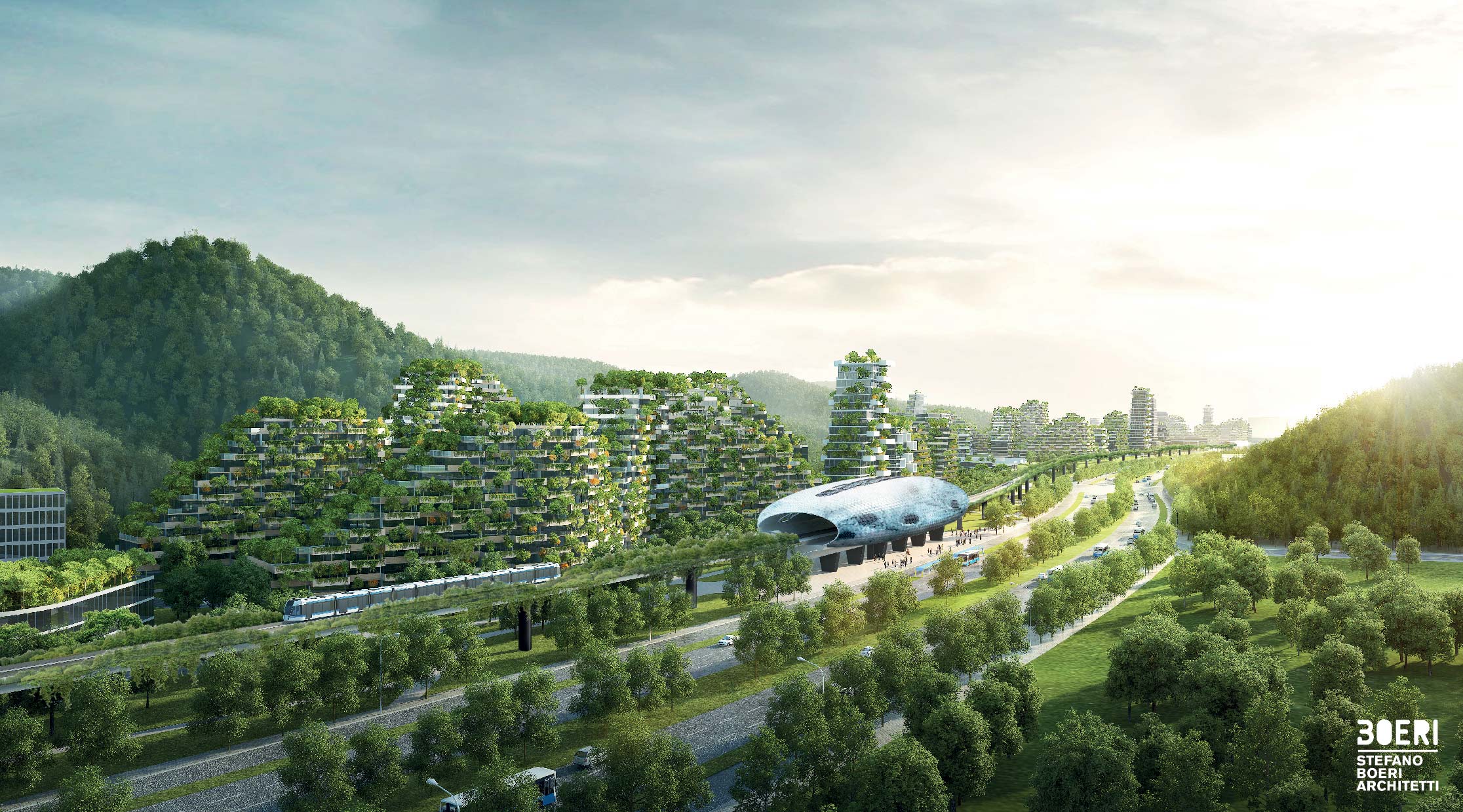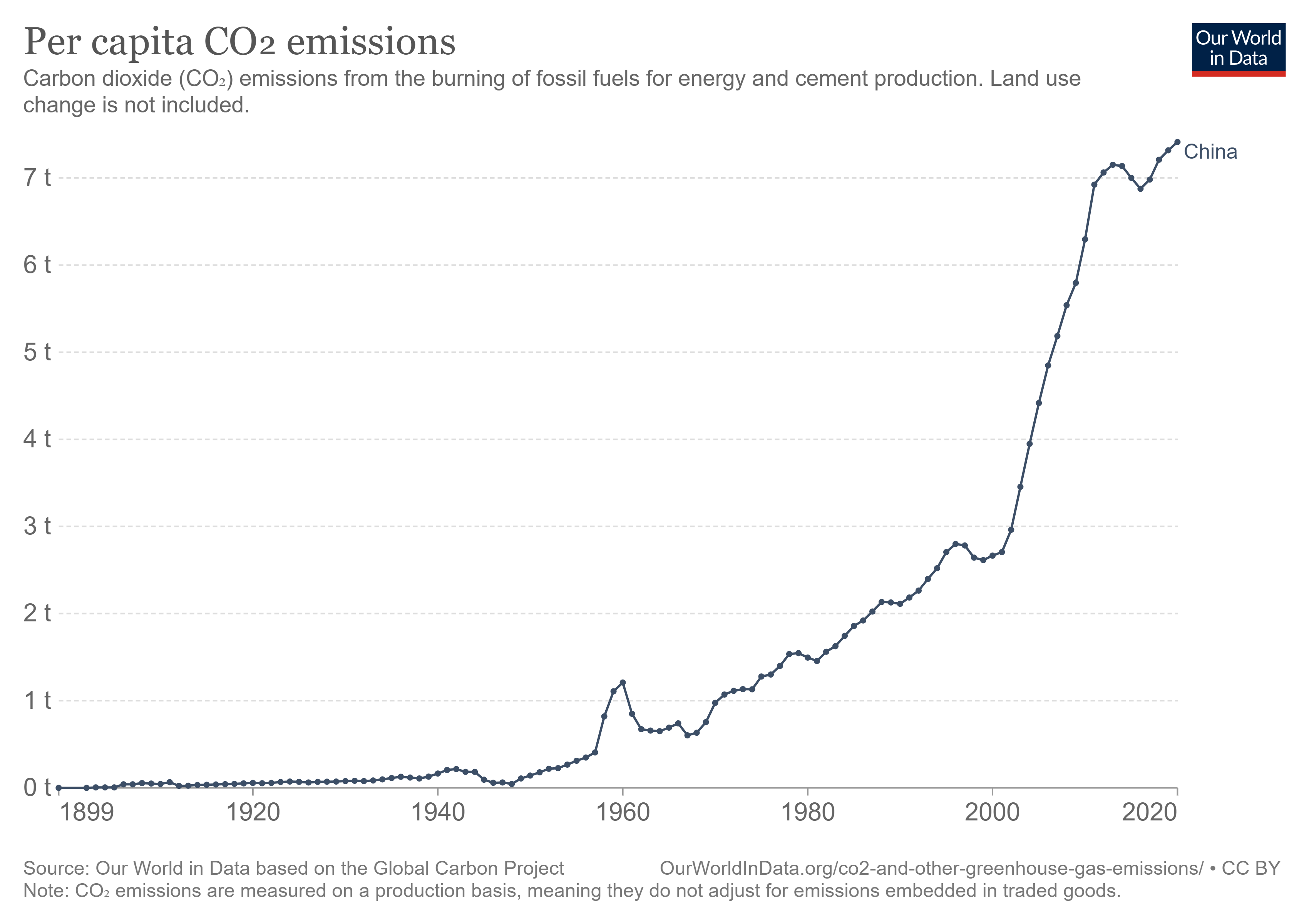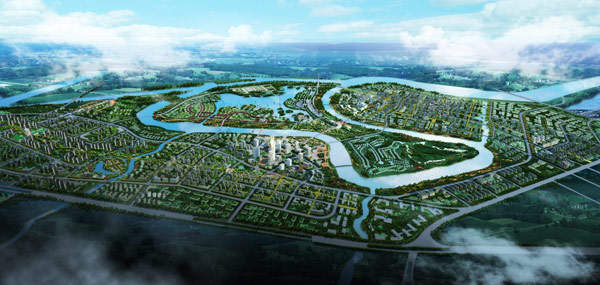Will Sustainable Cities Help China Meet its Decarbonization Targets?
January 13, 2022 | By Christine Ow Junior Consultant, Bridge Consulting | Image Source: Stefano Boeri Architetti
Let’s imagine a future where cities were actively contributing to our fight against climate change, not merely taking from nature and expending copious amounts of resources. If the future is green, how will eco-cities play a role in it?
In 2021, China released its 14th Five-Year Plan which is routine for the country but an important document that signaled among other things China’s climate goals. For those analyzing China’s climate policy, some elements of it seem almost contradictory, especially pertaining to carbon emissions.
According to the 14FYP China sets out to reduce its CO2 intensity by 18% by 2025. At face value this promise sounds like a solid commitment by one of the world’s largest polluters to drastically reduce their emissions levels, however, CO2 intensity is not the same as CO2 levels in a literal sense. Emissions intensity refers to the level of carbon emitted per unit of GDP, which could still result in an increase in absolute levels of CO2 if China’s GDP continues to grow. Similarly, while President Xi Jinping announced to the United Nations General Assembly that China will cease funding for overseas coal projects, such as those previously planned under the Belt Road Initiative, China has been burning more coal than ever to meet local energy demands.
In light of these contradictions, many critics of China have been questioning whether the country can meet its goal of a carbon peak by 2030 and carbon neutrality by 2060. Despite this, it is important to recognize that China is not ignoring climate change, if anything the country has been investing both economic and political energy into potentially meeting these goals. This article explores one facet of China’s carbon emissions reduction strategy that has gotten a little less attention: sustainable architecture, specifically eco-cities, and forest cities. Will these technologies make a dent in China’s seemingly insurmountable level of carbon emissions?
What is sustainable architecture?
To put it simply sustainable architecture refers to “buildings designed to limit humanity’s impact on the environment”. Architects and engineers can achieve these in a variety of ways such as using sustainable materials, integrating water conservation systems, and making buildings more energy-efficient. Overall, as countries continue to build more cities there is increasing interest in the art and science behind making cities more sustainable. China is no different.
In fact, since the 11th Five-Year-Plan, in 2006, China has consistently set out goals to improve commercial building energy efficiency to minimize the energy consumed and thus decrease carbon emissions from their cities. President Xi Jinping has also publicly endorsed the transition to more sustainable cities by coining the term “Park City” on a 2018 visit to Chengdu where he called upon leaders to start integrating eco-consciously into urban planning.
As a result of this continued interest, China has since developed eco-cities and forest cities. In the blueprint, the country has plans to construct up to 285 eco-cities however not all of them have necessarily come to life. Some notable examples of eco-cities include:
- Sino-Singapore Tianjin Eco-city, located 45km east of Tianjin, and an infrastructural collaboration between China and Singapore.
- Shanghai Dongtan Eco-city which first broke ground in 2005 but is currently on an indefinite hiatus.
Forest cities are a much newer concept but the first of its kind was proposed in 2017 by Italian firm Stefano Boeri Architetti who designed the Liuzhou Forest City, a literal city blanketed in greenery to mitigate its carbon footprint.
Why does it matter?
It is interesting and important to look at China’s eco-cities and forest cities because of the sheer amount of carbon China’s urban centers emit. It’s no secret that China is one of the world’s top emitters, in a 2019 study by the Rhodium Group it was found that the country is responsible for 27% of the world’s greenhouse gas emissions. China’s per capita CO2 emissions are also staggering at 7.41 tonnes in 2020, the highest it has ever been. Out of all the carbon emitted in the country, it should come as no surprise that urban centers contribute the most to it with a 2018 study finding that China’s cities are responsible for up to 85% of the country’s carbon emissions.
Yet, China’s cities are not going to stop growing. As the country continues to modernize its economy it will be accompanied by a growing rate of urbanization. Cities are going to be an undeniable part of China’s future development, yet, at the same time, there is increasing pressure both from within and the global community for China to be more environmentally friendly. Therefore, there is a need for us to understand one of the country’s ongoing strategies to mitigate its carbon emissions which is sustainable architecture.
Check out our two-part series on China’s population trends and how it relates to air pollution and other social issues: Reflections from the 2020 China Census: Growing Cities, Ballooning Pollution | Reflections from the 2020 China Census: A Silver Tsunami, A Reluctant People
Have they lived up to their reputation?
As mentioned earlier sustainable architecture makes big promises about its purported ability to reduce waste and emissions levels, similarly, China’s eco and forest cities have similar ambitions. For example,
- Shanghai Dongtan Eco-city was envisioned to be entirely reliant on renewable sources of energy, which coupled with reduced energy demand would save 350,000 tons of CO2 emissions every year. Water consumption was said to be reduced by 43% and it would have been a zero-waste city.
- Sino-Singapore Tianjin Eco-city was planned to increase the proportion of waste recycling to 60%, derive at least 20% of their energy from renewable sources, and obtain at least 50% of the water from nontraditional sources like rainwater capture.
- Liuzhou Forest City also has made big promises claiming it can absorb 10,000 tons of CO2 and 57 tons of pollutants each year. If these cities lived up to their projected impacts it would make a significant dent in China’s current levels of urban pollution.
Unfortunately, for now, most of these numbers remain optimistic goals confined to the drawing board. For starters, while China has made plans to build hundreds of eco-cities most have failed to proceed into the actual construction phase. Even the Shanghai Dongtan Eco-city which was touted as the project that will serve as an example for future eco-cities has been stuck in an indefinite hiatus for years. Practically, cities that have been somewhat constructed like the Sino-Singapore Tianjin Eco-city struggle to attract residents and businesses necessary for the city to develop and flourish.
There is a myriad of reasons that have been cited for why these cities have failed to live up to their promises, from them being too expensive to build, failing to be sensitive to local cultures which are displaced, and simply failing to provide the necessary infrastructure to support its growth and attract residents.
So, to put it simply, China has been very enthusiastic about pursuing the eco-city ideal but it has yet to figure out how to implement it in a way that is truly sustainable and meets the needs of its growing urban population.
Looking towards the future
It is tempting to get pessimistic when looking at the current state of China’s eco-cities initiative but dismissing its potential would be a hasty decision. The reality is there is a global push to make urban dwellings more environmentally friendly and to reduce emissions all around. Therefore, the challenges China currently faces in building green cities are not isolated to them alone. If anything, it is a common problem many countries around the world face and will continue to face as they explore technological and innovative solutions to climate change.
While much of China’s “progress” has been limited to ambitions in a proposal, globally, such idealism should be encouraged to push our scientists, architects, urban planners, and politicians to imagine a world where cities will have a smaller impact on the environment. Harnessing the power of dreams and realizing it with science and innovation is the inventors’ dream and eco-cities should be no different. Moving forward, China should focus not only on making functional eco-cities a reality but also work with other countries, like Iceland and the United States, that are developing similar initiatives for knowledge and technology sharing. It is only through cooperation can we as a global community make a lasting impact.
So, to answer the question we started with. Can sustainable cities help China meet its decarbonization targets? The answer is, for now, not quite yet, but there are unfulfilled potentials we should strive to achieve.
About the Author
Christine Ow
Christine is a Junior Consultant, based in Los Angeles, California, with a passion for sustainable development and environmentalism. She is an experienced researcher with experience in policy analysis, environmental studies, global health, and communications. Find Christine on LinkedIn.






